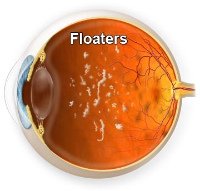|
What are Floaters in the Eye?
Have you noticed spots in your field of view? Do those spots sometimes look like spider webs or flies in your field of vision? Do those spots look more apparent when you look at the sun or view an object with a bright background? You may have eye Floaters. 
The inside of the eye is not hollow. As you can see from the diagram above, there is a gel that is found behind the crystalline lens and in front of the retina (the tissue in the back of the eye). This gel is known as the vitreous. With time this gel breaks down. This process results in the jellylike substance getting more fibrous in some areas and more liquid-like in others. What are Causes?
The process of the vitreous breakdown is primarily age-related, beginning around your mid-thirties. In addition to breaking down, the vitreous shrinks. With time, the vitreous may shrink enough to pull completely away from the back of the eye. For this reason, people with Myopia (or nearsightedness) who have slightly elongated eyeballs may notice Floaters earlier. Another potential cause is trauma. In order to view the content, you must install the Adobe Flash Player. Please click here to get started.
Whatever the cause, you need to be mindful of change. If you notice these for the first time, make sure to schedule an appointment with an eye care provider in order to make sure that the normal aging process is the cause or if you had ocular trauma, then that no adverse effect resulted. When you go see your eye doctor with this complaint, expect to have a dilated fundus examination, or DFE. A DFE involves instilling dilation drops in your eyes and waiting for your pupils to dilate. Once the pupils dilate the eye doctor can examine your vitreous for Floaters and your eye for Retinal Problems. These may annoy you from time to time, especially when you are in a sunny place or you are trying to read or use the computer, but they are not generally harmful. Now suppose your aging vitreous gel tugs on a piece of retina as it shrinks away from the back wall of the eye. This can result in a small hole or tear of the retina. Any break of the retina can allow fluid to get behind the retina and push it completely away from the back of the eyeball. This serious Retinal Problem is known as Retinal Detachment. As mentioned earlier, be mindful of change. If you already see Floaters but notice new, larger ones, or more frequent ones, especially accompanied by flashes of light in your peripheral vision, these could be the signs and symptoms of an impending Retinal Detachment. Worse yet is the sign of a dark veil across part of your field of vision, or the appearance of a curtain falling and the vision appearing like you are looking through water. These are symptoms of a Retinal Detachment. A Retinal Detachment is a true vision threatening emergency. If the retina is not reattached within a day or two, its cells will die and you will be left with permanent partial or total vision loss in that eye. Can They be Eliminated?
Unfortunately the answer is no. Floaters do not go away and instead may worsen gradually. Suppose you experience a complication like Retinal holes, Retinal tears, or Retinal Detachment after noticing a change in Floaters. If you have a small retinal break such as a Retinal hole or Retinal tear, a retinal surgeon can repair it with the use of lasers. If you have a large Retinal hole, Retinal tear, or Retinal Detachment, then surgery is indicated. |




